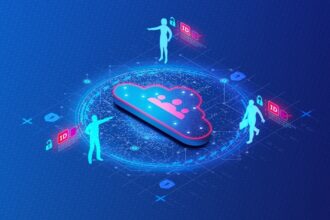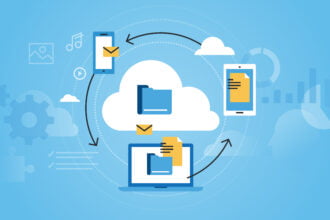There are many important considerations for people using cloud technology. Lots of businesses have already moved to the cloud. One of the most important issues is cloud security.
Cyberattacks have been named one of five top-rated risks in 2020, according to Global Risks Report for both private individuals and businesses. In 2021 the tendency is not expected to slow down as in IoT sector alone cyberattacks are projected to double in the next five years. To make matters even more extreme, the report also bluntly states that the detection rates of the attacks in the US are at the miniscule 0.05 %. These figures may not be much better for resources being attacked on cloud networks.
The news might be alarming but it should also serve as a reminder how important cyber resilience is to an organization, even in an age where so many resources are stored on the cloud. Businesses that have cyber resilience in their DNA are better than others by more than 30% at preventing, detecting, and responding to cyberattacks.
If the answer is so easy why the worrying statistics? Sadly, it is quite frequent that at the early stages of product development cybersecurity for the cloud tends to be overlooked. Which is a mistake you simply can’t afford to make, because you are leaving a door open for any security issue or attack to impact your business. No doubt, the right decision would be to take security into account from the very beginning. The soon the better.
Moving to the cloud and common security issues
Cloud technologies have been gaining a lot of traction and popularity recently across all industries and are expected to reach more than 1.25B of dollars by 2028. Indeed, the cloud has a lot to offer to businesses. From not having to obtain hardware on-premises to the ability to the numerous scalability options. However, the cloud is often seen as a solution to all problems and companies rush to move overlooking their security needs and issues that might arise.
The important thing about cloud-native development or migrating your old software to the cloud is having the right skills and the right team to be able to operate there. But before that, companies actually have to look back and ask themselves whether the cloud suits their business structure and business model and what advantages they have after implementing that. The next step would be making a cloud assessment plan for your project and preparing your team to be able to implement and support the cloud, even if you delegate this to the cloud provider, there should be some person from your side to control all things.
One more challenge of moving to the cloud is regulatory and legal compliance that depends significantly on the industry you’re operating in and should be also addressed to your cloud provider, but should be kept in mind by the business entity.
The other common security issue you might be faced with are fraudulent activities, data leaks, and general hindrances to long-term innovation. And the right approach to adopting cloud computing and preventing these threads is in building cyber security and cyber resilience strategies which we discuss later and making them work together. Because just being on the cloud just for the sake of it and not taking security as a part of it is a waste of time and money for your business.
Cybersecurity vs cyber resilience: how they differ
Cybersecurity refers to a company’s ability to protect its systems, network, and data from cybercrimes. While cyber resilience is a company’s ability to deliver their services, operations, and despite possible cyber events, and their capability to maintain work with the system or data being compromised. It covers both the hacker and malicious attacks and human error factors. Cyber resilience covers cyber security, as well as risk mitigation, business contiguity, and business resilience.
Both aspects are important and should be a part of the company’s strategic vision. While cyber security helps minimizing the risks of an attack getting through, it is up to cyber resilience to minimize the impact once the attack is successful.
How to build your cyber resilience program for the cloud: pieces of advice
When you start working on your cyber resilience program for your cloud resources, it’s important to remember that it’s a process rather than a destination. It’s not something you can accomplish, get it off your to-do list and be done with it. Cyber security resilience is achieved slowly and over time and even then, you should continue working on it.
It’s true when they say that cyber resilience improves over time. And when working on it, you should bear in mind that while cloud technology is important, you need the right people who will run the tools and extract the information. You should strive to achieve a balance of the three most important components of your program – people, processes, and technologies.
Here are some other pieces of advice on how you can work on your cyber security resilience as a cloud-based company:
· Make it a part of your mindset. To really embrace cyber security resilience, you have to make it a part of your mindset. Only then you can count on it being a part of your product design and development. You also need to understand that you should spread the mindset by educating your people. And in this process, you will be able to see what’s missing and fix it.
· Make pentesting a part of a regular security check process. In industries such as healthcare, gaming, financial and other penetration testing of cloud resources is a part of a standard IT process. However, many companies across industries tend to think of it as a one-time thing. In reality, it only gives you a current idea of what your products look like. The important thing is to do it frequently, making it a part of the application assessment process. Systematic pentesting might help identify some gaps in your cyber resilience program but ultimately, it’s just a snapshot of what is happening. You should rely on it completely.
· Adopt a hacker way of thinking. Meaning think from the very beginning about how your product might be misused and how you need to protect your customers and employees from data breaches on the cloud. There should be a person within your team who sets needed security requirements and will educate the development team to build a product secure by design.
Other important things worth keeping in mind when optimizing your cloud network for greater security:
– Analyze current cyber security practices;
– Define your maturity level;
– Conduct security awareness training for the different departments on a regular basis.
Make sure you focus on security sooner rather than later. The later you are in your product development cycle, the harder it is to fix any architectural issue, and consequently, the higher is the price.
The cost of remedying issues once you are in production is sufficiently higher compared to what you would pay at the beginning when working on requirements for your software.
Conclusion
Today no one is safe from getting hacked. Your resources aren’t necessarily safer on the cloud. unless you take the right precautions. But what distinguishes a successful business from a not so much – how they act once an incident does occur. Make sure that cyber security is on top of your list of priorities, practice simulations of attacks, and constant learning. And remember that cyber resilience is about thinking ahead, working on your readiness for the attack, and preparing for the worst-case scenarios. And if you lack internal knowledge to achieve that, hire security professionals who will drive the processes. And remember that at the end of the day you have a responsibility before your clients and customers, and that’s all that matters.











